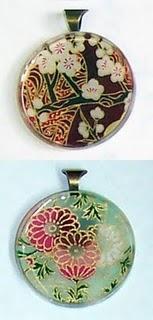Japanese Floral and Forest Pendants

My first assignment for the Indian edition of Marie Claire was to write a book review of Kamila Shamsie’s novel Burnt Shadows. Having never written for a glossy mag before, I was quite excited about this opportunity—but nervous too. Bigger publications have a tendency to censor unflattering sentiments that might alienate potential advertisers, and when it comes to fiction, I’m not easy to please. If I failed to be impressed by Shamsie’s work, would I still get the gig? Fortunately, I never had to find out.
The book’s back cover description may fool a potential reader into thinking Burnt Shadows is about the life of a Japanese woman in Nagasaki post-atomic bomb detonation, but it’s not. Although she is the only constant figure throughout the novel, Hiroko Tanaka is simply the conduit through which one is introduced to an entire cast of global characters, all of whom are beautifully fleshed out and whole. Many times, the reader learns of a character far before that person is actually introduced into the main story, which makes it all the more exciting to meet them when they finally do make their entrance. The seamless shifts from one person’s perspective to another create a cinematic element to the story, and while reading Burnt Shadows I found myself wondering if Shamsie has sold the film rights to this book, as it is enormously adaptable to the big screen.
So if this is a jewelry review, why am I spending so much time hyping a novel? Like Tanaka herself, this review is the conduit through which the Japanese Floral and Forest pendants are introduced, as both have a particularly florid Japanese aesthetic. The cherry blossom design on the Japanese Floral, in particular, pendant brings to mind the two unprecedented and (so far) un-replicated events that eventually led to the end of World War II at the expense of thousands of civilian lives in Japan. It brings this to mind because the springtime blooming of the delicate pink flowers in both Washington, D.C. and Hiroshima’s Peace Park are an annual reminder of these devastating events; the trees in the U.S. capital city were originally gifted in 1912 by Tokyo Mayor Yukio Ozaki as a symbol of friendship between the two countries. It’s a friendship that comes and goes.
One’s seemingly harmless and well-intended personal choices necessarily accumulate and intersect with the lives of others to create cause and effect simultaneously and mold our individual and collective pasts, presents, and futures in ways both known and unknown. In Burnt Shadows, the concept of home is fluid and dynamic, as Shamsie embodies the world in her characters. The story glides from one geographic landscape to another—Delhi, Karachi, New York, Afghanistan—giving the reader a glimpse of what life may be like for those living in multiple locales while blurring topographic borders that are arbitrary yet endlessly meaningful. Everyone is an outsider in one context or another, yet all fit together and fill each others' lives with what was previously missing. Every character has a role to play, and each role is as important as the next.
Though largely weightless, the Japanese Floral and Forest pendants are heavy with meaning: impossible love that is made possible, unlikely friendships forged from necessity, betrayal of the worst kind, premature loss of loved ones. This is my own association for this pair of pendants, a representation of natural beauty crafted from the dirt by human hands that toiled and provided care. I’ll be sure to wear them with the requisite grace and humility they deserve.